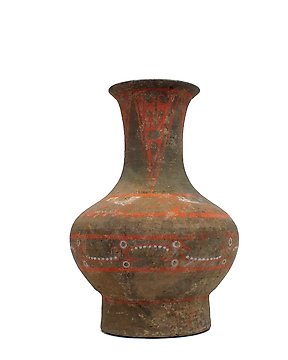
Terrakotta Veldig sjelden og strålende malt keramikk Hu Pot, med TL-test - 31 cm
Nr. 85201463

Nr. 85201463

Tang dynasty
China
Province of Shaanxi.
Height: 27 cm. Width: 26 cm.
With Certificate of authenticity dated back to 4 July 2006, from Jan Becker - Amsterdam, Kunst - en Antiekhandel. A copy of the certificate accompanies this lot.
Expert's note: with the original colors (polychrome)!
Provenance:
Old and important Dutch private collection, Mr. P. Nouwen, Rotterdam, since 2006 and thence by descent.
Jan Becker - Amsterdam, Kunst - en Antiekhandel
Collection of Mr. P. Nouwen, acquired from above and thence by descent.
Note: It will be professionally packed and safely sent in a wooden crate within 3 working days by FedEx. Shipped with Insurance!
The horse standing foursquare with head raised and looking forward, with a clipped mane and docked tail, the rider and saddle modeled as one piece, the rider posed as if holding the reins, his face expressively modeled, with a thin white pigment over the gray clay, with traces of original red, black and orange pigment.
- All items legal to buy/sell under The Netherlands covering cultural patrimony, and are guaranteed to be as described or your money back.
- The result of the thermoluminescence test, is consistent with the dating of the item, Tang dynasty. Sampling in 3 different points
- The result of the Pre-dose test is consistent with the dating of the item and the test confirms old firing without any kind of artificial x-ray treatments!
Additional Information:
Tang Dynasty
National unification during the Tang dynasty brought about centuries of social stability and economic prosperity. Ceramic art evolved further towards maturity and important kiln centres emerge across the country.
The repertoire of mortuary objects in Tang tombs closely followed those of earlier periods. The majority was still made of pottery clay and came in many forms and styles, which illustrate the evolution and traits of Tang ceramic art. These objects can broadly be divided into five categories namely tomb guardians, guards of honour, attendants, animals, and utilitarian wares.
Tang dynasty tomb figures are pottery figures of people and animals made in the Tang dynasty of China (618–906) as grave goods to be placed in tombs. There was a belief that the figures represented would become available for the service of the deceased in the afterlife. The figures are made of moulded earthenware with colour generally being added, though often not over the whole figure, or in naturalistic places. Where the colouring was in paint it has often not survived, but in many cases, it was in sancai ("three-colour") ceramic glaze, which has generally lasted well.
The figures, called mingqui in Chinese, were most often of servants, soldiers (in male tombs) and attendants such as dancers and musicians, with many no doubt representing courtesans. In burials of people of high rank there may be soldiers and officials as well. The animals are most often horses, but there are surprising numbers of both Bactrian camels and their Central Asian drivers, distinguished by thick beards and hair, and their facial features. The depictions are realistic to a degree unprecedented in Chinese art, and the figures give archaeologists much useful information about life under the Tang. There are also figures of the imaginary monster "earth spirits" and the fearsome human Lokapala (or tian wang), both usually in pairs and acting as tomb guardians to repel attacks by both spirits and humans. Sets of the twelve imaginary beasts of the Chinese Zodiac are also found, usually unglazed.
The most common animals, and the most likely to be large and carefully modelled and decorated, are horses and camels. Both sorts range from animals without harness and saddlery to those with elaborately detailed trappings, and carrying riders or, in the case of camels, heavy loads of goods.
The graceful ladies with plump faces and bodies (so called Fat ladies), the smartly dressed civil officials, the mighty warriors, the horses with saddles and accessories, as well as camels and non - Chinese figurines are all results of the potter’s keen observation and superb virtuosity. They allow us to visualise life in China more than a millennium ago.
- A Certificate of Authenticity from Becker Antiques (specialist in Chinese pottery since 1969, Amsterdam) will accompany the item.
Condition: Very good condition. Wear consistent with the age, some loss of color. Please be advised that all ancient Chinese pottery objects had been buried in tombs and are excavated from there. Therefore, they can always have some restorations. Also worth of note is that the item is more than 1200 years old.
Important information.
The seller guarantees that he is entitled to ship this lot.
It will be professionally packed and safely sent in a wooden crate by FedEx.
Buyers are responsible for import regulation and restrictions of their own country.
Hvordan kjøpe på Catawiki
1. Oppdag noe spesielt
2. Legg inn det høyeste budet
3. Å gjøre en sikker betaling